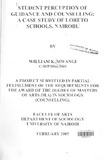| dc.description.abstract | The main objective of this study was to investigate students' perception of the guidance and counselling programme in two randomly selected Loreto Schools in Nairobi, Kenya. Specifically, the study sought to determine if students' perception of the guidance and counselling programme was affected by the teacher-counsellor's age, gender or the level of training in counselling skills. According to Foley (2002), perception is a process by which orgamsms interpret and organize sensation to produce a meaningful experience of the world.
The data used in the study were collected by means of in-depth interviews with the heads of guidance and counselling departments, and by means of interview schedules administered to randomly selected students, all of whom were female and in secondary school. Data obtained were analyzed using both quantitative and qualitative analysis techniques. The Chi-square test was used to show the degree of relationship between variables.
Among the main findings was that the age, gender and formal counselling skills of the teacher-counsellor had no significant relationship with the students' perception of the guidance and counselling programme in schools. That is, when students sought counselling services from a teacher-counsellor, whether the teacher-counsellor was male or female was not an issue. When seeking counselling services, students, according to the findings of the study, did not consider the age of the teacher as significant. Teacher-counsellors had different levels of formal training in counselling skills. The study showed that the teachers' level of formal training in counselling skills did not affect the students' perception of the guidance and counselling department in terms of their inclination to seek counselling services. Hence, other factors that could affect the students' perception of the guidance and counselling programme should be looked into.
The study also found that students consult more .with their parents than with their teacher
counsellors. When facing emotional problems, students preferred to consult with their
~
parents, especially in their first year in school. This was mainly because most of them had
not become acquainted with their teacher-counsellors. It was established that students also
consulted their peers when dealing with emotional problems. Students, especially those who were not staying with a relative, sought counselling from their friends and classmates. These friends and classmates were within the same age-brackets as the students seeking counselling. This shows the significant role peers played in counselling.
The results obtained in this study have various implications for the effective provision of guidance and counselling services in Loreto Schools. A strong relationship is essential among the students, the teacher-counsellors, other teaching staff and the school administration. There is need for provide adequate rooms and other facilities. The school should distinguish cases that require counselling and discipline and deal with them accordingly, and also encourage students to seek help through counselling. Fellow teachers needed to be supportive by providing guidance and counselling in their own way.
Based on the findings, the following recommendations are made so that the provision of guidance and counselling in schools can be enhanced: first, there is need to sensitize the students on the need to consult and seek counselling services from the teacher-counsellors. Second, the government and school administrators should explore the possibility of having school counsellors' who will not have teaching responsibilities. This would enable counsellors to have more time for counselling. Third, peer counselling should be introduced in schools since some students often consult their friends and classmates. Fourth, schools should be well equipped with counselling materials such as books, magazines and videotapes; and should have adequate venues for better provision of counselling services.
Areas of further research include: first, a comparative study to establish the students' perception of guidance and counselling using more schools of both male and female students. Second, a comparative study of the effectiveness of guidance and counselling in schools with counsellors who are not teachers, and schools with teachers who double up as counsellors. Third, a study to find out if the curricula in teacher-training colleges and universities are geared towards producing teachers who are well equipped to deal with counselling issues in schools. | en |

